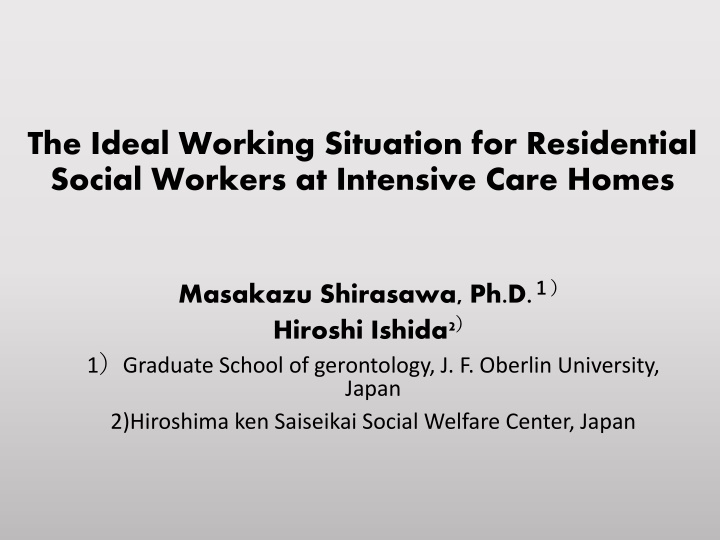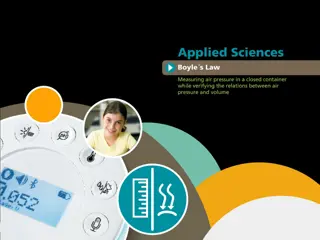
Optimizing Working Conditions for Residential Social Workers in Intensive Care Homes
Explore the roles and challenges faced by residential social workers in Japan's intensive care homes, aiming to redefine their functions. Understand the differences between insured persons requiring long-term care and support and the services available for them within the Japanese long-term care insurance system.
Download Presentation

Please find below an Image/Link to download the presentation.
The content on the website is provided AS IS for your information and personal use only. It may not be sold, licensed, or shared on other websites without obtaining consent from the author. If you encounter any issues during the download, it is possible that the publisher has removed the file from their server.
You are allowed to download the files provided on this website for personal or commercial use, subject to the condition that they are used lawfully. All files are the property of their respective owners.
The content on the website is provided AS IS for your information and personal use only. It may not be sold, licensed, or shared on other websites without obtaining consent from the author.
E N D
Presentation Transcript
The Ideal Working Situation for Residential Social Workers at Intensive Care Homes Masakazu Shirasawa, Ph.D. Hiroshi Ishida2 1 Graduate School of gerontology, J. F. Oberlin University, Japan 2)Hiroshima ken Saiseikai Social Welfare Center, Japan
Todays subject of my presentation Today s subject of my presentation Although in Japan, intensive care homes have duty to employ residential social workers as professional staffs, their functions are vague and they are mocked as Jacks of all trades. In my presentation, I try to clarify primary scope of work from the point of view of residential social workers themselves.
Table : Differences between first and second insured persons first insured persons second insured persons 40 65 age 65 and over Numbers of the insured 29 million 780 thousand 42 million 990 thousand Eligibility of services Needed to Long- term care or support Added needs of care or support to by disease caused aging Numbers and % of accreditation 5 million 150 thousand (17.2%) 160 thousand (0.4%) Collection methods of premium Deduct from pension In a lump with premium of Medical insurance March, 30, 2013
The insured is accredited The insured is accredited as being in need of long-term care or support by the municipality. Certified persons are categorized into seven stages which consist of two stages of those requiring support and five stages of those requiring long-term care. A person requiring long-term care is defined as a person who is expected to be in need of constant long-term care, in all or partial basic motions in daily life such as having meals, bathing and excretion due to physical or mental disability. A person requiring support is defined as a person who is expected to constantly experience impediments in daily life due to physical or mental disability.
services are available for persons requiring long-term care. The long-term care insurance system in Japan covers 21 at-home medical/nursing care services and 3 nursing care home services. Nursing care homes (1)include intensive care homes are known as a special nursing homes for the elderly, provide services to persons who require constant long- term care, but cannot be cared for at home. (2)health institutes for long-term care of the elderly provide nursing, long-term care and functional training with the aim of returning home. (3)long-term health care facilities for the elderly manage treatment and provide nursing, long-term care and functional training with the aim of engaging in daily life according to capacity. A plan to abolish the last type of facility is on hold due to a concern over securing new homes for its residents.
About Intensive care homes Intensive care homes are 8,000 homes accommodating 520,000 residents, of which nearly 80% have dementia and 70% require intensive nursing care level, and supporting those who cannot live independently at home. Intensive care home employees include care workers, nurses, residential social workers and et.al as professional staffs. For example, an intensive care home admitted 50 persons need to arrange 15 and over care workers, 2 and over nurses, one residential social worker, one doctor who are full-time employment or pert-time employment, one nutritionist, and one care manager who work full-time or doubled with other job.
Figure 1: Changes in breakdown of the service users (comparison between FY2000 and FY2013) (ten thousand) 500 450 residents of long-term care insurance facilities 89 400 (18.9%) 350 300 1.71 times 250 200 382 (81.1%) 52(34.9%) 3.94 times 150 100 home service users 97(65.1%) 50 home service users 0 FY2000 FY2013
Aims of this study This presentation, I focused residential social workers at intensive care home. Though mocked as Jacks of all trades, residential social workers conduct a variety of tasks. This study is to summarize the tasks residential social workers perform and their ideal tasks, and to propose what their ideal tasks should be from the perspective of residential social workers themselves.
Methods of this study Questionnaire surveys were posted to 400 residential social workers on March 2014 and 107 valid responses were obtained. We asked residential social workers about both their ideal tasks and the tasks that they actually carried out. They were asked 41 questions derived from the results of a previous study, and answers were graded on a five-point scale. .
Table Table 2 2 Basic Basic attributes attributes of of the the responders responders Gender Gender Male Female 45 42.1 Aged Aged 40 and under 60 56.1 40 and upper 47 43.9 Double Double as as care care managers managers or Yes No Years Years of of experience experience as as residential residential social 5 years and under 5 years and over Academic cademic background background junior college graduate and lower 53 49.5 university and over 54 50.5 62 57.9 or not not 27 25.2 80 74.8 social worker worker 34 31.8 70 65.4
Figure 2 Results of Factor Analysis ideal scope of work actual scope of work operation management admission support rights advocacy life consultation related admission support operation management Making care plan by assessment care plan making welfare education center related everyday life support welfare education center related everyday life support coordination with external organizations assessment coordination with External organizations securing valuables
Results of factor analyses As the results, similarity and difference of factors actual and ideal residential social worker s scope of work are clarified. Similarity factors of actual and ideal residential social worker s scope of work are admission support, and everyday life support for residences, operation management of facility, coordination with external organizations, and welfare education center related persons. Difference of factors actual and ideal residential social worker s scope of work is that ideal scope of work has rights advocacy for residences and actual scope of work have securing residences valuables. Actually residential social workers are not functioned as right advocator for the frail elderly of Intensive Care Homes. So, it is important task that residential social workers function to develop from securing residences valuables to advocate residences all rights.
Summary of factor analyses Actual scope of work have life consultation related tasks . Meanwhile, a variety of categories exist in the current life consultation related tasks , creating their image of Jacks of all trades . It is important that social workers need to discuss who work each of contents of life consultation related tasks and to clear the aim of needed scope of work. And I can understand that although actual scope of work is limited to making care plan by assessment, and that social workers wish both to assess residences and to make their care plan independently each other as a scope of work.
Table T-test of attributes by 8 factors (actual work scope) admissio n support life consult ation related operatio n manage ment Making care plan by assessm ent welfare educatio n center related everyday life support coordinat ion with external organizati ons securin g valuabl es attribute Gender N.S. N.S. N.S. N.S. N.S. N.S. N.S. N.S. Aged N.S. N.S. P<0.01 N.S. N.S. N.S. N.S. N.S. Doubled as care managers or not N.S. N.S. P<0.001 P<0.001 N.S. N.S. N.S. N.S. Years of experience as residential social worker P<0.05 P<0.05 P<0.05 N.S. N.S. N.S. N.S. N.S. Academic background NS NS P<0.05 NS NS NS NS NS
Table T-test of attributes by 8 factors (ideal work scope) operatio n manage ment rights advocac y admissio n support care plan making welfare education center related everyd ay life suppo rt assess ment coordinati on with external organizati ons attribute Gender N.S. N.S. N.S. N.S. N.S. N.S. N.S. N.S. Aged P<0.05 N.S. N.S. N.S. N.S. N.S. N.S. N.S. Doubled as care managers or not N.S. N.S. N.S. P<0.001 N.S. N.S. P<0.01 N.S. Years of experience as residential social worker P<0.01 N.S. P<0.01 P<0.001 N.S. N.S. N.S. N.S. Academic background NS P<0.05 N.S. NS NS NS P<0.05 NS
Results of t-tests (1)Gender was no significant relationship of 8 factors of both actual and ideal work. (2)As age increased, actual and ideal levels were high in operation management (3)When the social workers doubled as care managers, actual and ideal levels were high in care plan making or making care plan by assessment , and the ideal level was high in assessment . (4)As years worked as residential social workers, actual and ideal levels were high in operation management and admission support (5)As years worked as residential social workers. the ideal level was high in care plan making , and the ideal level was high in assessment (6)As academic grade is lower, actual level was high in operation management , and as academic grade is higher, the ideal level was high in rights advocate and assessment
Summary of this study These findings revealed the ideal tasks for residential social workers were to support admission, design care plans based on assessments, provide support in daily life and protect residents rights, operation management, welfare education, and collaboration with other organizations, though in reality, the assessment tasks were unclear even when the social workers had been involved in making care plans, as was the protection of residents rights. It clarifies that doubling as care manager facilitates the work in the social work area of tasks, since the assessments and making of care plans for residences are cited as their ideal tasks. And the more the facility required experience or age, the more the levels increased in operation management; it is necessary to investigate if this task requires experience or if young, capable, social workers can perform it.
I'd like to finish by thanking you for listening.
Todays stream of presentation (1)Explain introduce Japanese situation of aging (2)Explain intensive care homes which are one services of long-term care insurance system Main tame (3)The Ideal Working Situation for Residential Social Workers at Intensive Care Homes based on evidences clarified from our research focused to residential social workers.
Figure 1: Projection on the population in Japan Population (ten thousand) Census figures Estimate as of 2012 Max no of elderly 38.78 million (2042) 75 % of persons 75 65 74 % of persons 65~74 15 64 0 14 The Ministry of Internal Affairs and Communications Statistics Bureau as of March 1, 2013
number of the elderly in need of long-term care or support rapid increase in the number of the elderly in need of long- term care or support is inevitable. It is expected that by 2025 there will be 7.50 million elderlies in need of long-term care or support assistance, which is 1.7 times the current 4.47 million elderlies in need of long-term care or support. the long-term care insurance system was established in April 2000.
Financial resources for long-term care insurance Financial resources for long-term care insurance are split into public funds (50%) and insurance premiums (50%). The breakdown of public funds is 25% from central government and 12.5% each for prefectures and municipalities. Premiums are split among the first and second insured persons who will bear 10% or 20 % for each service received. Two years ago, high income elderly who 20 % of service receivers ware needed to pay 20 % for each service received.
Table 3: Changes in the number of first insured persons, accredited persons and service users (a comparison between FY2000 and FY2013) FY2000 FY2013 A rate of increase 1.43 First insured persons 2,165 3,103 Accredited persons 218 564 2.59 Service users 149 471 3.16 (ten thousand)
intensive care homes covered by long-term care insurance The long-term care insurance system in Japan covers 21 at-home medical/nursing care services and three types of long-term care facilities for the elderly. They are (1) include intensive care homes , (2) health institutes for long-term care of the elderly and (3) long-term health care facilities . intensive care homes are known as a special nursing homes for the elderly, provide services to persons who require constant long-term care, but cannot be cared for at home.
Situation of intensive care homes The most commonly used facilities are the intensive care homes and todays I focused on intensive care homes at my presentation. There are 8,000 such homes accommodating 50,000 residents, of which nearly 80% have dementia and 70% require intensive nursing care level, and supporting those who cannot live independently at home. Last year we changed to limit the admission eligibility from five stages of those requiring long-term care to upper 3 stages of those requiring long-term care. Intensive care home employees include care workers, nurses, residential social workers and et.al as professional staffs.
Table 5: Total expense of long-term care benefits and trends in premiums for first insured persons total expense (trillion) Premiums per 1 month for first insured persons (JPY ) FY2000 3.6 2,911 FY2001 4.6 2,911 FY2002 5.2 2,911 FY2003 5.7 3,293 FY2004 6.2 3,293 FY2005 6.4 3,293 FY2006 6.4 4,090 FY2007 6.7 4,090 FY2008 6.9 4,090 FY2009 7,4 4,160 FY2010 7.8 4,160 FY2011 8.2 4,160 FY2012 8.9 4,972 FY2013 9.4 4,972 FY2014 4,972 FY2025 21.0 About 8,200






















